Artisan Sourdough Loaf for Beginners
When I say this is an artisan sourdough loaf for beginners, I mean anyone can make it! This sourdough bread recipe is my go-to. I make it once a week and recommend every baker to use it. No matter if you just started sourdough baking yesterday or 3 years ago, you’ll love how simple this recipe is!
This recipe post includes a video tutorial so you can make it alongside me, step-by-step!
This post may contain affiliate links of items I know and love. Read our disclosure policy for more information.
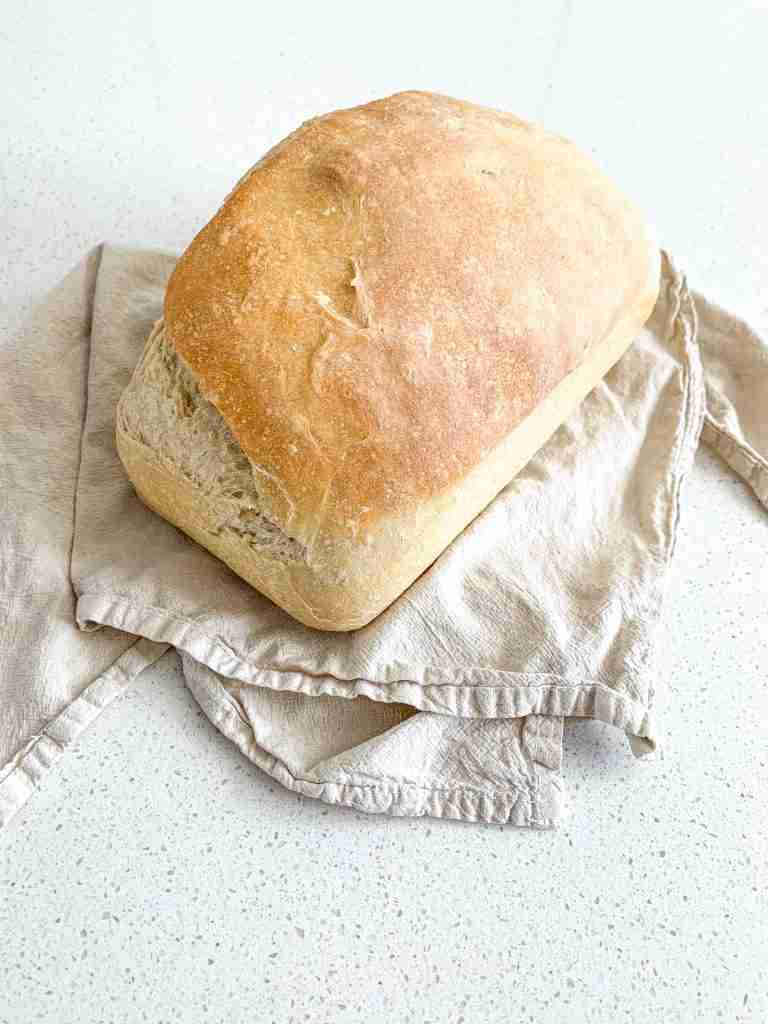
If you want to make this recipe but don’t have a sourdough starter, no worries! Grab my free guide so you can make your own starter at home.
If you’re new to sourdough baking and feel hesitant, or you have questions, I’ve got something for you! I broke down the basics of what you need to know about sourdough baking in my free sourdough baking guide for beginners. I highly recommend grabbing a copy!
About this Artisan Sourdough Loaf for Beginners
There are many sourdough bread loaf types out there, many of which are here on the blog. This particular beginner’s loaf has the same base as my artisan boule but is shaped and baked like a sandwich loaf. It’s the perfect combination!
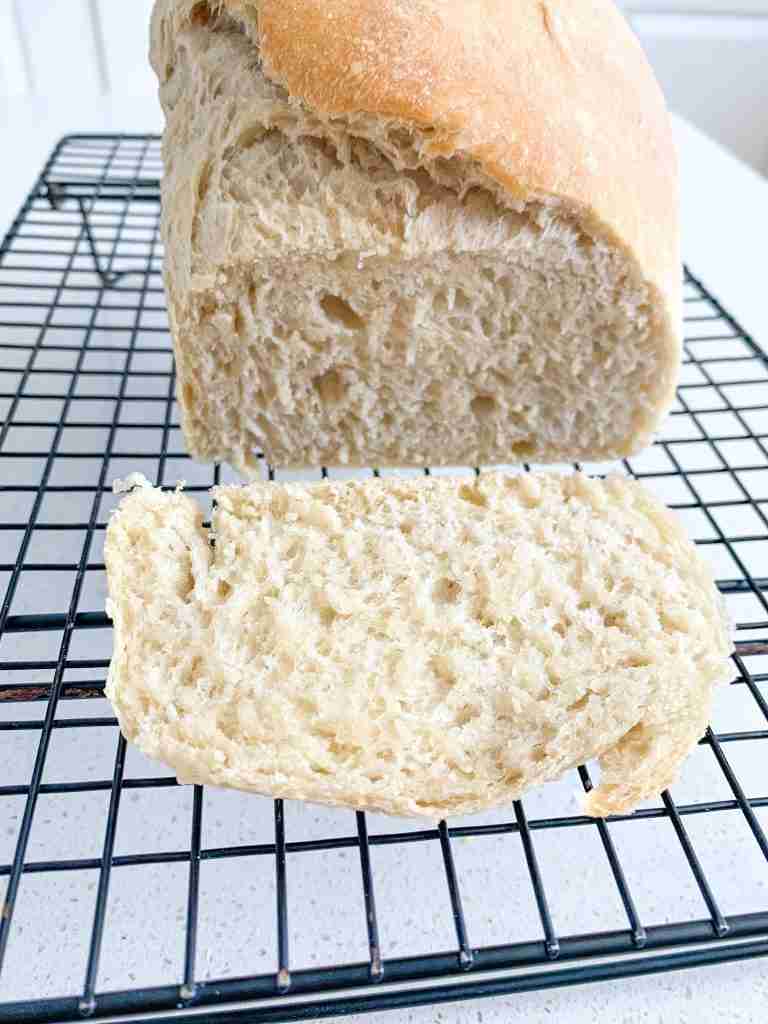
Sourdough Bread Baking Tips
- Make sure your starter is active! Before you get started with this recipe, you need to feed your starter a 2:1 ratio of flour to water 4–12 hours before you start. Your sourdough starter needs to be very active and bubbly to begin.
- Let the dough bulk ferment for 12 hours. It is important to let your dough bulk ferment for the full 12 hours. It should double in size and have air bubbles in it.
- Place the dough in a warm spot to rise. For both the bulk ferment and the second rise after shaping, your dough needs to be at room temperature in a non-drafty place. If your dough doesn’t look like it’s doing anything halfway through the rises, you need to place it in a slightly warmer area. This can be in a turned-off oven with the light on and oven door open, or you can slightly warm the oven to about 75-80 degrees Fahrenheit, then turn it off and place your dough inside with the door shut. Never leave the oven on, even on the keep warm setting, with fermenting dough inside. Your dough, for both rises, needs to double.
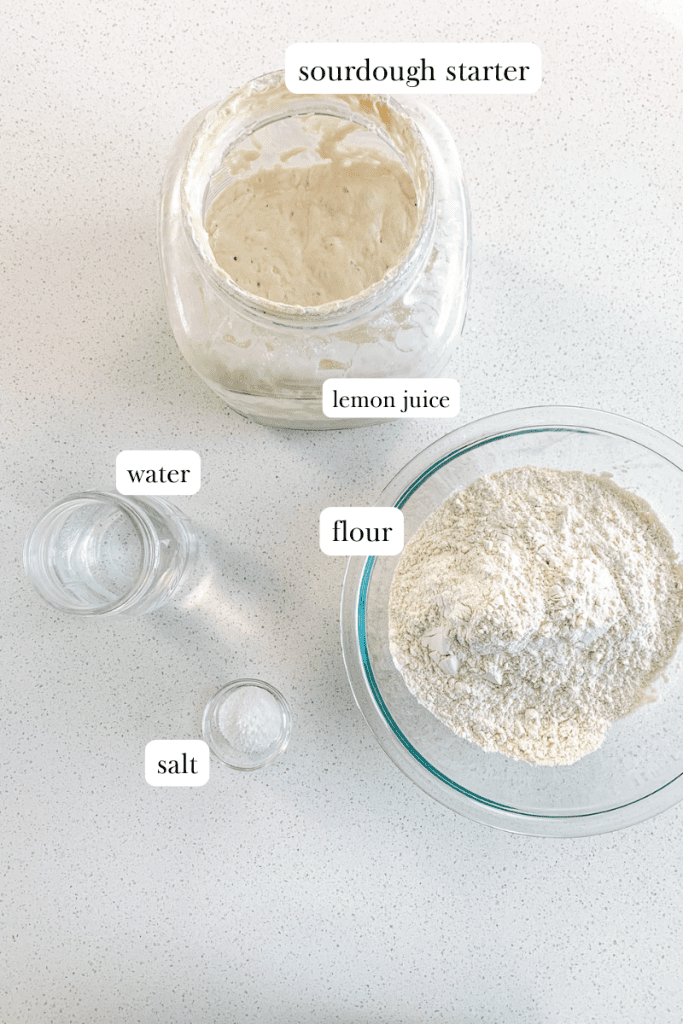
Ingredients You’ll Need
- fed sourdough starter (feed starter 4-12 hours before using)
- water
- salt
- all-purpose flour
How to Feed a Sourdough Starter
Feed your sourdough starter 4-12 hours before using it. To feed it use a 2 parts flour to 1 part water ratio. For example if you feed your starter 1/2 cup flour, you’ll want to add 1/4 cup water. Learn more about starter feeding with this post: The Best Sourdough Starter Feeding Ratio & Guide
Things To Avoid With The Ingredients
Never use bleached flour or city water that’s not filtered. Both of these items can kill your sourdough starter which will cause bread not to rise. Also never use hot water or cold water, it needs to be room temp or slightly warmed to protect the sourdough cultures.
Helpful Sourdough Baking Tools for This Recipe
- Large Glass Bowl
- Bread Whisk
- 9×5″ loaf pan— this is the perfect loaf pan size; stainless steel is best.
For baking tool substitutes and an explanation of how to use each of these listed above, checkout the blog post a Complete List of Sourdough Baking Supplies You Need.
How to Make This Artisan Sourdough Loaf for Beginners
Prep Your Starter
Feed your starter 4-12 hours before starting this recipe. I recommend feeding it a 2:1 ratio of unbleached flour to filtered water to get the same results as I do when you make this recipe. Your starter needs to be active, bubbly, and a thicker consistency to begin this recipe.
Make the Dough
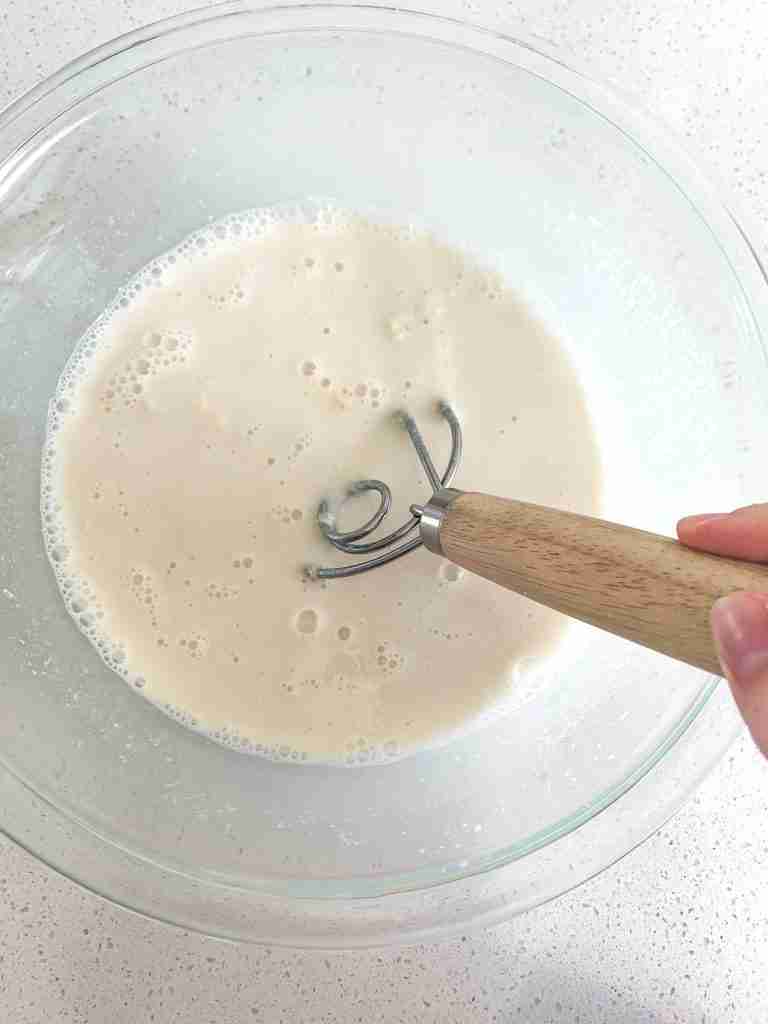
In a large mixing bowl, add in sourdough starter, water, and salt, then stir until combined.
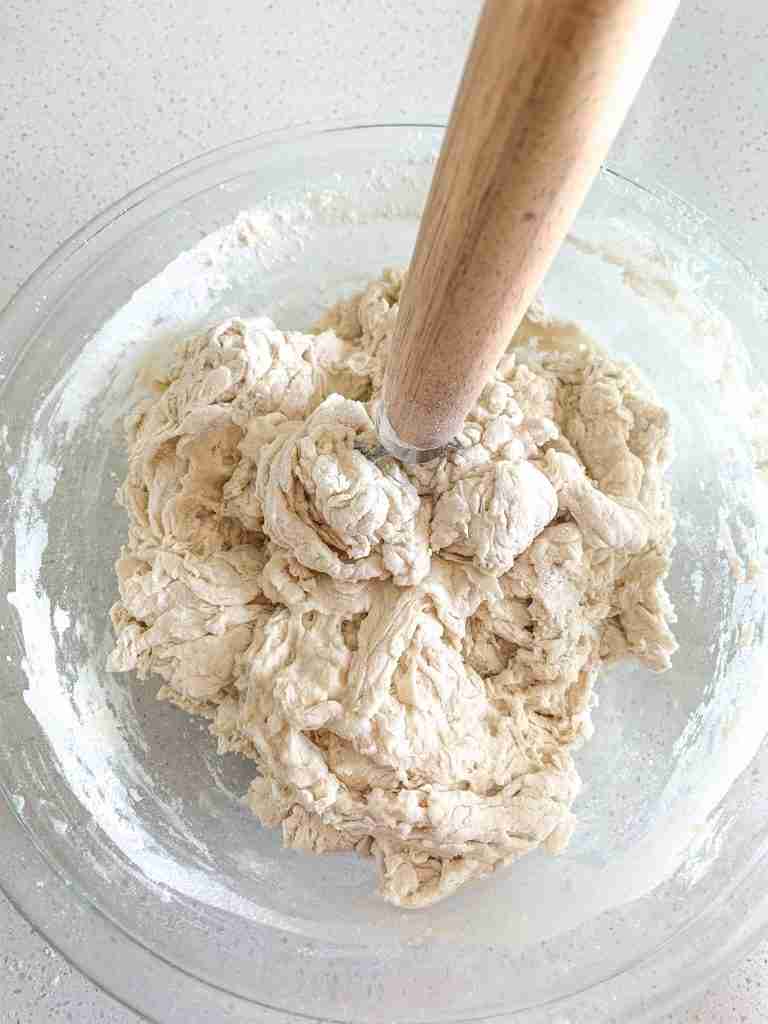
Add flour and stir until a shaggy dough forms. Use your hands to bring the dough into a ball. If this isn’t working add 1-2 Tablespoons of extra water to help but don’t do this if not necessary.
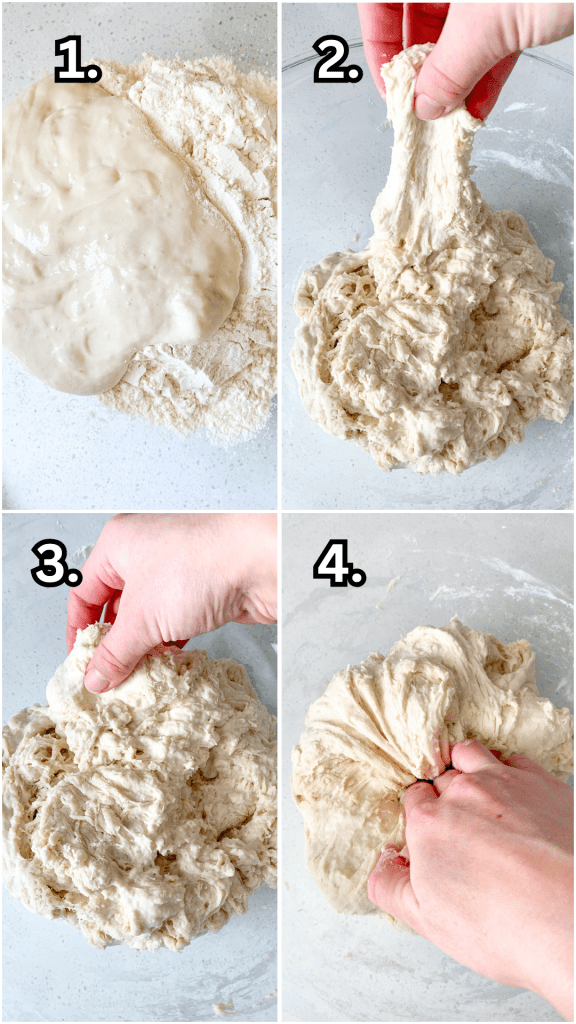
Stretch and Fold
Cover dough with a lid loosely, a damp kitchen towel (that’s been wet then rung out), or plastic wrap. Let dough sit for 30 minutes on the counter at room temperature.
After 30 minutes, begin the first round of stretch and folds. To do this pull a section of the dough upward, folding it into the center, and pressing it down. Repeat this around the dough for 1-2 complete circles.
Cover the dough again and let it sit at room temperature for another 30 minutes. Then, repeat a second round of stretch and folds.
Bulk Ferment
Bulk ferment dough on the counter top at room temperature for 12 hours (helpful information in notes below)
Shape Loaf & Rise

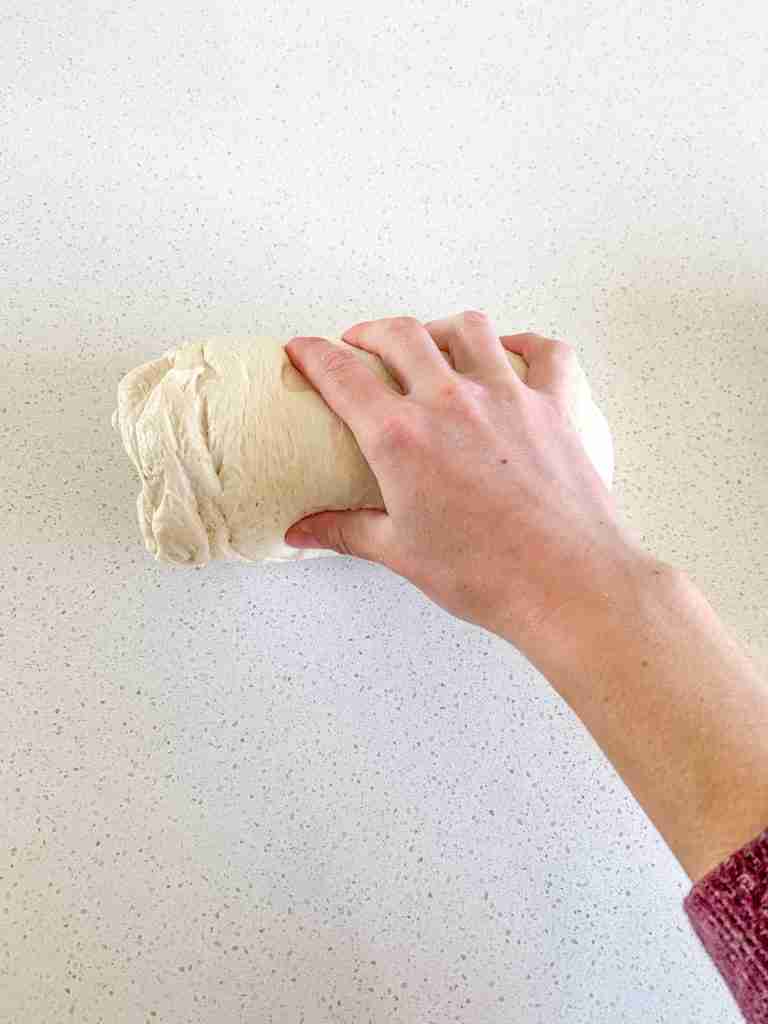
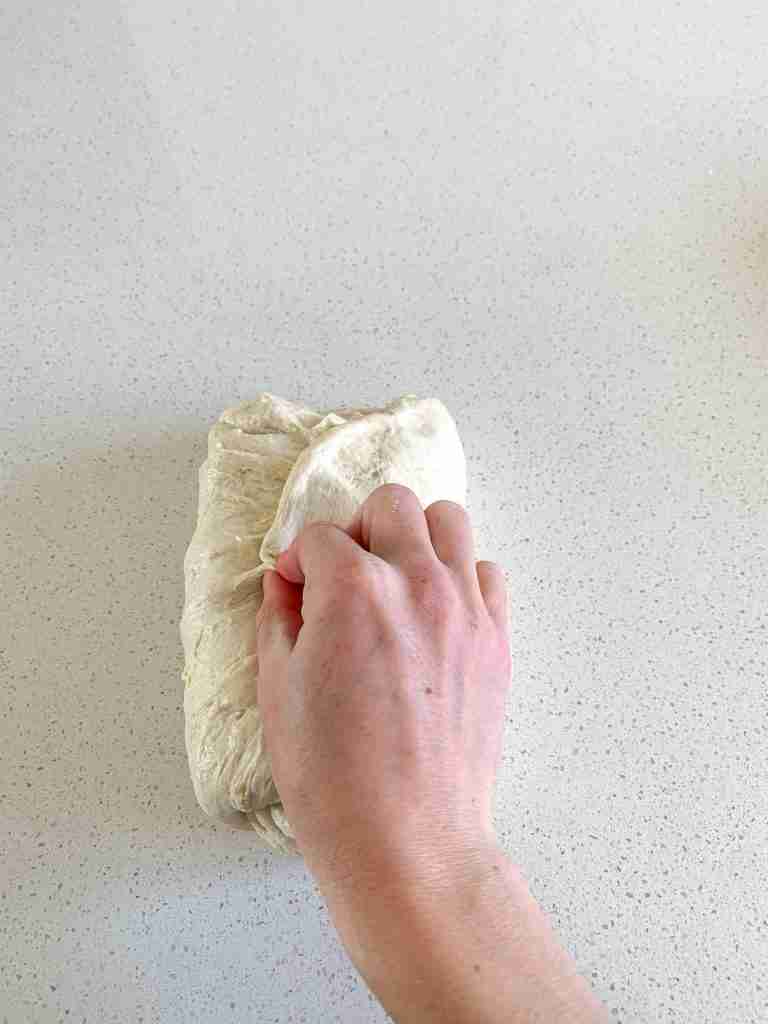
When the 12 hour bulk fermentation is complete place the dough on the counter (no flour needed) and pull it into a rectangle then roll it into a log


Place in a loaf pan and cover with a towel. Let rise on the counter at room temperature for 3-4 hours. It needs to double in size (see notes below for helpful information).
Bake Bread
Bake at 375 degrees for 45-50 minutes.
Let cool on a cooling rack for 5 minutes in the pan then take out of pan to cool rest of way.
How to Stretch and Fold Dough

This infographic above is showing you the steps of a sourdough stretch and fold technique through imagery. I’ve created this to give you a visual when making this recipe. It’s super simple to do!
Video Tutorial
Storing Sourdough Bread
Store completely cooled bread in an airtight container at room temperature (in a cool dry place) for 5 days. After that place the container in the fridge for 3 more days.
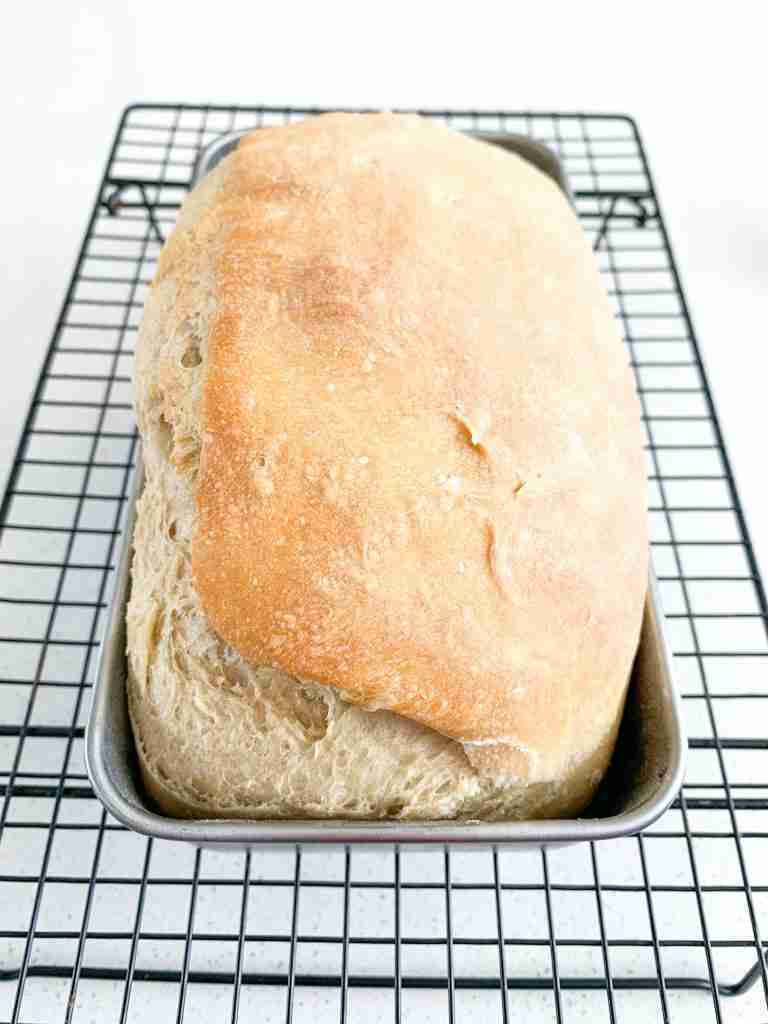
Freezing Sourdough Bread
If you want to freeze baked bread, package it in an air-tight bag or container and freeze it for up to 3 months.
More Sourdough Bread Recipes
Beginner’s Sourdough Bread Loaf Recipe
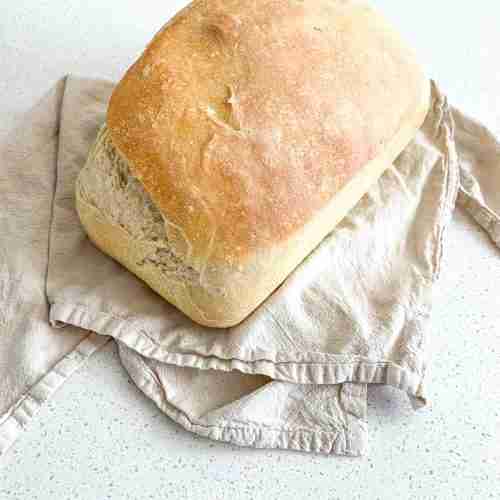
Artisan Sourdough Loaf for Beginners
Ingredients
- 1/2 cup fed sourdough starter (feed starter 4-12 hours before using)
- 1 1/4 cups water
- 2 tsp salt
- 3 1/2 cups all-purpose flour
Instructions
- BEFORE YOU GET STARTED: Feed your starter 4-12 hours before starting this recipe. I recommend feeding it a 2:1 ratio of unbleached flour to filtered water to get the same results as I do when you make this recipe. Example: Feed 1 cup flour + 1/2 cup water and let the starter sit on the counter at room temperature until it's bubbly and has grow in the jar. Your starter needs to be active, bubbly, and a thicker consistency to begin this recipe.
- In a large mixing bowl, add in sourdough starter, water, and salt, then stir until combined.
- Add flour and stir until a shaggy dough forms. Use your hands to bring the dough into a ball. If this isn’t working add 1-2 Tablespoons of extra water to help but don’t do this if not necessary.
- Cover dough with a lid loosely, a damp kitchen towel (that’s been wet then rung out), or plastic wrap. Let dough sit for 30 minutes on the counter at room temperature.
- After 30 minutes, begin the first round of stretch and folds. To do this pull a section of the dough upward, folding it into the center, and pressing it down. Repeat this around the dough for 1-2 complete circles.
- Cover the dough again and let it sit at room temperature for another 30 minutes. Then, repeat a second round of stretch and folds.
- Bulk ferment dough on the counter top at room temperature for 12 hours (helpful information in notes below)
- When the 12 hour bulk fermentation is complete place the dough on the counter (no flour needed) and pull it into a rectangle then roll it into a log
- Place in a loaf pan and cover with a towel. Let rise on the counter at room temperature for 3-4 hours. It needs to double in size (see notes below for helpful information).
- Bake at 375 degrees for 45-50 minutes.
- Let cool on a cooling rack for 5 minutes in the pan then take out of pan to cool rest of way.
Video

Notes
- Make sure your starter is active! BEFORE YOU GET STARTED: Feed your starter 4-12 hours before starting this recipe. I recommend feeding it a 2:1 ratio of unbleached flour to filtered water to get the same results as I do when you make this recipe. Example: Feed 1 cup flour + 1/2 cup water and let the starter sit on the counter at room temperature until it's bubbly and has grow in the jar. Your starter needs to be active, bubbly, and a thicker consistency to begin this recipe.
- Let the dough bulk ferment for 12 hours. It is important to let your dough bulk ferment for the full 12 hours. It should double in size and have air bubbles in it.
- Place the dough in a warm spot to rise. For both the bulk ferment and the second rise after shaping, your dough needs to be at room temperature in a non-drafty place.
- If your dough doesn't look like it's doing anything halfway through the rises, you need to place it in a slightly warmer area.
- This can be in a turned-off oven with the light on and oven door open, or you can slightly warm the oven to about 75-80 degrees Fahrenheit, then turn it off and place your dough inside with the door shut.
- Never leave the oven on, even on the keep warm setting, with fermenting dough inside. Your dough, for both rises, needs to double.
- If your dough doesn't double even in the warmer area, there is a problem with your starter. It is too weak to ferment the dough even in a warm environment.
- To fix this, you will want to leave your starter out on the counter for 2 days and feed it every 12 hours at a 2:1 ratio of unbleached flour to filtered water.
- For example, 1 cup unbleached flour + 1/2 cup filtered (or bottled) water.
- Make sure you're using unbleached flour and filtered or bottled water to do this. If you don't, it will affect your starter strength. Reverse osmosis water (or any water that uses salt in the filter) can make the starter weak.
- This will strengthen the cultures in your starter to give you fluffy baked bread and treats. After the 2 days, you can go back to feeding it like usual (once a week if stored in the fridge or once a day if stored on the counter). Be sure to use the 2:1 ratio feeding from here on out.
